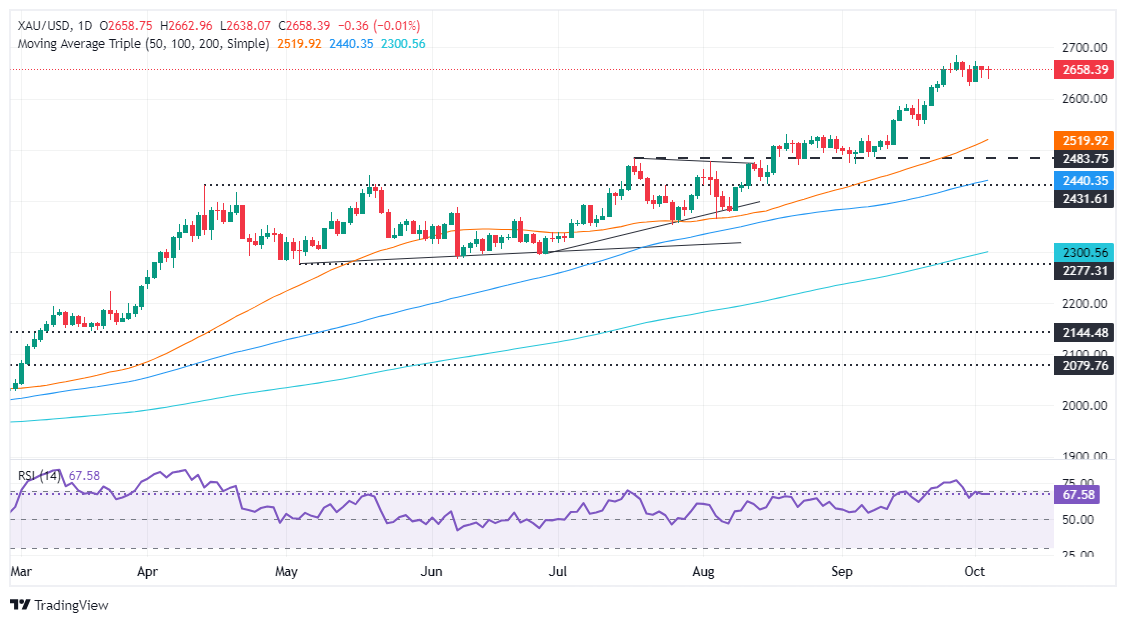Gold Prices Surge Amid Escalating Geopolitical Tensions and US Economic Data
- Gold prices jump from $2,638 to $2,659 as tensions between Israel and Iran rise and US Treasury yields increase.
- US labor market data shows softening, while ISM Services PMI indicates improved business activity in September.
- US Dollar Index (DXY) rises by 0.35%, with 10-year Treasury yields climbing to 3.84%, impacting expectations for a significant rate cut in November.
Gold prices experienced a notable rebound during the mid-North American session on Thursday, reaching a high of $2,659 after hitting a daily low of $2,638. This surge was fueled by escalating concerns surrounding the conflict between Israel and Iran, as well as a stronger US Dollar. Additionally, market expectations for a substantial policy easing by the Federal Reserve (Fed) diminished, leading to a boost in US Treasury yields. As a result, the XAU/USD pair is currently trading at $2,659.
Geopolitical Developments and Market Sentiment
Wall Street experienced losses amidst heightened geopolitical risks, with Israel moving its military into Lebanon despite a recent missile attack by Iran. President Joe Biden’s public comments regarding a potential attack on Iranian oil facilities further fueled market uncertainty. Following these developments, gold prices edged higher, surpassing the $2,650 mark.
US Economic Indicators
The latest US labor market data revealed a softening trend, with a higher number of individuals filing for unemployment benefits than anticipated. However, the Institute for Supply Management (ISM) reported an improvement in business activity in September compared to the previous month.
Additional economic data indicated a contraction in Factory Orders for August, setting the stage for increased market volatility ahead of the upcoming US jobs report on Friday.
Fed Officials’ Remarks and Market Reaction
Comments from Fed officials have also influenced market sentiment, with discussions on the natural employment rate, inflation levels, and the importance of gradual rate adjustments over the next year. These remarks, coupled with rising US Treasury yields and a stronger US Dollar Index (DXY), have tempered expectations for a significant rate cut in November.
Key Market Insights and Expectations
- US Initial Jobless Claims rose to 225K, exceeding estimates, while the ISM Services PMI expanded to 54.9 in September.
- Factory Orders for August contracted by -0.2%, missing expectations, with Nonfarm Payrolls data for September expected to show moderate job growth.
- Market participants favor a 25 bps rate cut over a larger 50 bps cut, reflecting a more cautious approach to monetary policy adjustments.
Technical Analysis and Price Forecast for Gold
Despite some downward pressure, the overall uptrend for gold prices remains intact, with the Relative Strength Index (RSI) indicating bullish momentum. Potential price levels to watch include $2,650 as immediate support and $2,685 as a key resistance level.
In the event of a bearish scenario, a drop below $2,650 could lead to further downside, targeting key levels at $2,624 and $2,600. Conversely, a breakout above $2,685 may pave the way for a rally towards $2,700.
For visual representation, refer to the chart below:

Insights on Gold as an Investment
Gold FAQs
Gold has historically served as a store of value and a safe-haven asset, particularly during periods of economic uncertainty. Central banks actively hold gold reserves to bolster their currency’s stability and diversify their assets. The price of gold is influenced by various factors, including geopolitical tensions, inflation concerns, and currency movements.
Key Points:
- Gold is considered a safe-haven asset and a hedge against inflation and currency depreciation.
- Central banks hold significant gold reserves to support their currency and enhance economic credibility.
- Gold prices are inversely correlated with the US Dollar and US Treasuries, making it a popular diversification tool for investors.
- Market dynamics, geopolitical events, and interest rate changes can impact gold prices significantly.

